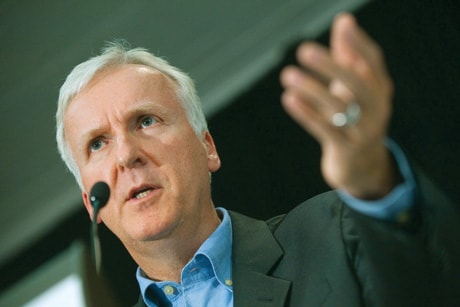EDMONTON — Hollywood mogul director James Cameron says he is appalled by the idea that residents living downstream of the Alberta oilsands are getting sick, getting cancer and catching deformed, tumour-addled fish.
He said regardless of what one thinks of Alberta’s oilsands, officials need to get to the bottom of what’s happening in the tiny northeastern Alberta community of Fort Chipewyan.
“The people in Fort Chipewyan are afraid to drink their own water. They’re afraid to eat the fish. They’re afraid of the river. They’re afraid to let their kids swim in the river,” Cameron told reporters Wednesday after wrapping up a two-day visit to the oilsands region.
The Ontario-born Cameron said he grew up swimming in rivers in the Niagara peninsula, gaining a love of water and nature that later influenced his blockbuster water movies like “Titanic.”
“I can’t imagine being told by my mom that I can’t swim in the river,” he said. “The idea of that is appalling to me. And for a community to live in fear like that — we need to look into this.”
He said an impartial third-party study needs to be conducted to determine the truth.
“We need to respect the First Nations communities for having their finger on the pulse of what’s happening to Mother Nature,” said Cameron, who spoke at a news conference with other native leaders including Shawn Atleo, grand chief of the Assembly of First Nations.
“If they say the fish taste different and they’re being affected, it would behoove us to listen.”
Failure to reduce the environmental impact of the oilsands, he said, will transform them into an eco-catastrophe that will punish generations to come.
“It will be a curse if it’s not managed properly,” he said. “It can also be a great gift to Canada, and to Alberta if it’s managed properly.”
During his visit, Cameron toured the oilsands, talked to scientists and oil executives and heard stories from the people of Fort Chipewyan. He met with Alberta Premier Ed Stelmach in Edmonton on Wednesday.
Residents in the region have long complained about metals and chemicals from the operations infecting fish and wildlife and making them sick. A 2009 Alberta Cancer Board study found the cancer rate was 30 per cent higher than expected in the tiny community of 1,200, but also noted the small sample size could skew the findings.
Cameron said Stelmach pulled out a study to refute the cancer statistics, but Cameron said numbers on paper don’t match up with the stories he’s hearing from those who live off the land.
“I find that (study) inconclusive,” he said.
Cameron is ranked at or near the top of the list of the most powerful people in Hollywood and is an emerging environmental activist. In the spring, he went to the wilds of Brazil to fight a proposed dam project that would flood the land of nearby indigenous people.
His latest movie “Avatar” is about indigenous people on a distant planet fighting mercenary business people in metal claw machines bent on destroying the natural environment to get at the minerals underneath.
In promoting “Avatar” this spring, Cameron publicly called the oilsands a “black eye” and fossil fuels a “dead-end” paradigm, prompting Stelmach to invite him to see the project for himself.
On Wednesday, Cameron struck a more diplomatic tone. He said he recognized the critical role the oilsands plays in the industrialized economy.
But he noted that while no one connected to the oilsands should be demonized, all the stakeholders seem to work in “individual bubbles of reality which do not intersect very much.”
Cameron said he also met with noted ecologist David Schindler, who made headlines recently with a study showing toxins and metals in the waters downstream of the oilsands have reached levels harmful to fish. He later publicized pictures of fish recently caught from Lake Athabasca. Some had tumours, others were deformed or discoloured.
A new team is being put together to study the impacts, but provincial scientists have long said any toxicity comes from the natural bitumen in the area.
Cameron said he’s skeptical: “It’s impossible to imagine a refining process and an extraction process on this scale that did not have negative environmental impacts. That would have to be some kind of immaculate conception.”
Stelmach told reporters their meeting was cordial, but he’s not sure of the outcome.
“I don’t know if we’ve changed anybody’s mind, but put it this way — by meeting, there’s a 50-50 chance,” he said.
“If I had not met it would have been zero.”
Stelmach also said the province is going to review health concerns in the community.
Cameron suggested that one short-term step would be a halt to future tailings ponds construction until more environmentally friendly technology is available. Stelmach wouldn’t say if he’ll act on that suggestion.
Alberta has been fighting an ongoing public relations battle over the oilsands. The industry has become the multibillion-dollar fulcrum of the provincial economy, but has drawn global scorn for its strip mining operations, greenhouse gas emissions and tailings ponds.
